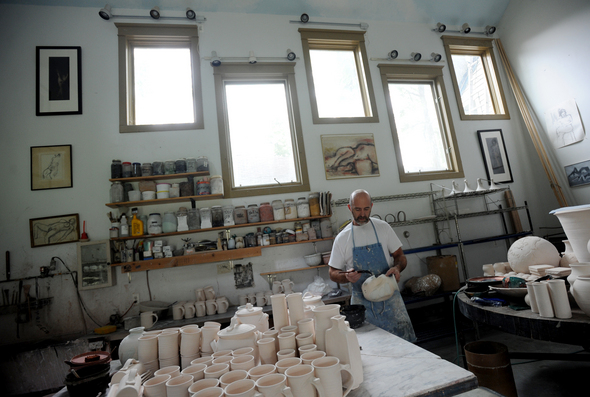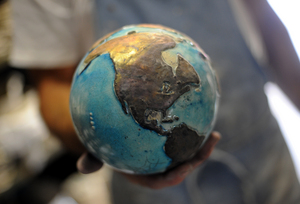Art Fairs 2010: Artists hope sales uptick continues from last year

Local artist Stan Baker glazes a pot in his studio in preparation for this week's Ann Arbor Summer Art Fairs.
Melanie Maxwell I AnnArbor.com
He introduced a new line of raku maps and globes to display alongside his plates, bowls and mugs. The move proved popular and helped him recover from one of the worst slumps in his 30 years at the fair.
"I may have been an exception to the rule. People still buy because my work is functional, but then, my globes are kind of odd, so I got lucky with those. Non-functional artists are having a harder time," says Baker, an Ann Arbor resident who exhibits on Main Street with wares priced from $15 to $625.

Stan Baker has been creating new work showcasing raku glazes on globes in preparation for Ann Arbor Art Fairs.
Melanie Maxwell I AnnArbor.com
The artists who adapted now go into this year's fair, from July 21-24, with hopes for decent sales.
Baker points out that even in bad times, the Ann Arbor Art Fairs provide 25 percent of his yearly income, and Baker does around 25 art fairs each year. Baker anticipates that this year's fair, which runs Wednesday through Saturday, will be better than last year's.
"For some, Ann Arbor's not their greatest show. Ann Arbor has always been a flagship show for me," he says.
"My theory is, people have been saving money and not going on vacation or buying elaborate gifts. Because they've been sacrificing, they're beginning to think they deserve to get themselves something. It's going to be better and better," he says.
Maggie Ladd, executive director of the South University Art Fair, says artists reported having good sales last year, "and that was echoed in the applications, which were up for all of us. Artists don't come back if they're not making money."
About 1,000 artists and artisans participate in the four fairs that make up the Ann Arbor Art Fairs.
A 2008 survey commissioned by the four art fairs showed that 17 percent came from out of state, she points out. More than half came from outside of Ann Arbor.
"They're not all economically challenged," Ladd says. "We assume because we live in an economy that's been really challenged that the artists might suffer. That's not the case."
It certainly wasn't for Linda Chamberlain, a painter who has exhibited along South University for five years. The 57-year-old Bay City resident had been doing well with large, expensive and surreal paintings until 2008, her worst year for sales. She went back to the studio and contemplated her next move, tweaking her work by introducing more color and whimsy.
Plus, she readjusted price points to make the work more affordable and began offering note cards and high quality reproductions.
Last year was her best ever.
"I tripled my sales last year in Ann Arbor," says Chamberlain, who declined to provide numbers. Her work sells in the range of $5 to $4,000.
"A lot of people time out with what they're doing, or they don't change. They don't care what the public wants. If you have sales, fine. If you don't, you only have yourself to blame," Chamberlain says.
Kathy Krick, director of the State Street Area Art Fair, says flat sales in 2007 and 2008 discouraged artists from returning last year - some 20 percent told her they weren't making the money they once did in Ann Arbor - but for those who hung in there, 2009 "exceeded their expectations. It was a terrific year for us."
Still, with more competition from other art fairs, sales will probably never reach the level of 10 years ago, Krick says.
Beth Crowder, a West Virginia painter who is part of the State Street Area Art Fair, was disappointed in sales last year. But plenty of regulars stopped by to tell her they would buy if they weren't saddled with other, more pressing expenses.
A regular exhibitor at the Art Fair for the last 20 years, Crowder had seen sales of her pastoral scenes rise and fall with the economy. Michigan has been so rough since 2007, she says, that this year she cut out shows in Rochester and Birmingham, limiting her state stops to St. Joseph and Ann Arbor.
Why not just bypass the state?
"I feel like I'm keeping my brand out there," says Crowder. "It's important for people to see new work you're excited about. It's important not to be crying the blues."
Julie Edgar is a freelance writer for AnnArbor.com.


Comments
15crown00
Mon, Jul 19, 2010 : 12:18 a.m.
people need jobs to pay basic bills.then u think of art.apparently the creative set doesn't understand that.not SURPRISING AT all.